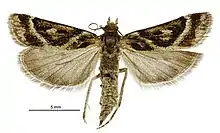| Eudonia xysmatias | |
|---|---|
 | |
| Female | |
 | |
| Male | |
| Scientific classification | |
| Domain: | Eukaryota |
| Kingdom: | Animalia |
| Phylum: | Arthropoda |
| Class: | Insecta |
| Order: | Lepidoptera |
| Family: | Crambidae |
| Genus: | Eudonia |
| Species: | E. xysmatias |
| Binomial name | |
| Eudonia xysmatias | |
| Synonyms[2] | |
| |
Eudonia xysmatias is a moth in the family Crambidae.[3] It was first described by Edward Meyrick in 1907. This species is endemic to New Zealand and has been observed and collected in Otago. This species inhabits wetlands. Adults are day flying and are on the wing in December and January.
Taxonomy
This species was first described by Edward Meyrick and named Scoparia xysmatias.[4] In 1928 George Hudson described and illustrated this species under that name.[5] In 1988 John S. Dugdale placed this species in the genus Eudonia.[2] The male holotype, collected by J. H. Lewis in the Old Man Range / Kopuwai in Central Otago, is held at the Natural History Museum, London.[2]
Description
.jpg.webp)
Meyrick described this species as follows:
♂. 19 mm. Head dark fuscous. Palpi 1+1⁄2, dark fuscous, lower longitudinal half ochreous-whitish. Antennae very minutely pubescent. Thorax dark fuscous, sprinkled with ferruginous scales. Forewings elongate, gradually dilated, costa almost straight, apex obtuse, termen faintly sinuate, rather oblique ; dark fuscous, irregularly strewn except on margins with yellowish-ferruginous scales, and partially suffused with black, especially about margins of first and second lines and towards dorsum anteriorly ; first and second lines represented by straight undefined series of whitish scales surrounded with yellowish-ferriiginous suffusion, strongly converging towards dorsum ; a small spot of white scales in middle of disc, followed by a black spot ; a well-marked black fascia beyond second line ; a few white scales indicating subterminal line : cilia ochreous-whitish, with dark-fuscous basal and grey median lines. Hindwings without hairs in cell ; dark grey sprinkled with blackish ; cilia ochreous-whitish, with dark-grey basal line.[4]
Distribution

This species is endemic to New Zealand.[1] Along with , This species has been observed or collected in Otago at the type locality of Old Man Range as well as at Bold Peak at the head of Lake Wakatipu, in the Kakanui Mountains and at Happy Valley.[5][6][7]
Habitat
This moth inhabits various wetlands.[6]
Behaviour
E. xysmatias is a day flying moth.[6] Adults are on the wing in December and January.[6][5]
References
- 1 2 "Eudonia xysmatias (Meyrick, 1907)". www.nzor.org.nz. Landcare Research New Zealand Ltd. Retrieved 27 January 2018.
- 1 2 3 John Stewart Dugdale (23 September 1988). "Lepidoptera - annotated catalogue, and keys to family-group taxa". Fauna of New Zealand. Department of Scientific and Industrial Research. 14: 158. doi:10.7931/J2/FNZ.14. ISSN 0111-5383. Wikidata Q45083134.
- ↑ Gordon, Dennis P., ed. (2010). New Zealand inventory of biodiversity: Kingdom animalia: chaetognatha, ecdysozoa, ichnofossils. Vol. 2. p. 458. ISBN 978-1-877257-93-3. OCLC 973607714. OL 25288394M. Wikidata Q45922947.
- 1 2 Edward Meyrick (June 1907). "Notes and descriptions of Lepidoptera". Transactions and Proceedings of the New Zealand Institute. 39: 110. ISSN 1176-6158. Wikidata Q110404133.
- 1 2 3 George Vernon Hudson (1928), The butterflies and moths of New Zealand, Illustrator: George Hudson, Wellington: Ferguson and Osborn Limited, p. 187, LCCN 88133764, OCLC 25449322, Wikidata Q58593286
- 1 2 3 4 Brian H. Patrick (1991). Insects of the Dansey Ecological District (PDF). Vol. 32. pp. 1–25. ISBN 0-478-01285-3. ISSN 0113-3713. Wikidata Q110318301. Archived from the original (PDF) on 30 December 2021.
{{cite book}}:|journal=ignored (help) - ↑ "Happy Valley Crown Pastoral Land Tenure Review Conservation Resources Report - Part 5" (PDF). www.linz.govt.nz. August 2006. Retrieved 11 November 2022.